|
Filmmaker David Sington can hardly be accused of taking the easy
road when it comes to picking topics. Gamma-ray bursts, magnetic
fields, Einstein's cosmological constant—these are just a few
of the tough-to-visualize subjects he has tackled in recent years.
Sington, a veteran of more than two dozen science documentaries,
believes there are some simple rules for making any movie, even one
that takes on high-level science. Here's his recipe:
 It's the people, stupid
It's the people, stupid
By far the most important ingredients in any film—drama or
documentary—are the people who appear in it. A successful film
will have interesting characters with whom the audience wants to
spend time. For me, deciding to make a film about something is
usually deciding to make a film about someone.
"The Ghost Particle" had its origins in my friendship with physicist
Dave Wark, whom I got to know while making a program for Channel 4
in England called "Einstein's Biggest Blunder." Dave told me about
his work at the Sudbury Neutrino Observatory during a Thanksgiving
party at our house. The science was fascinating, and Dave assured me
that neutrino scientists were good company, which proved to be the
case. Of course, those who appear in "The Ghost Particle" are there
because of their roles in the story and their ability to explain the
science clearly, but they are also in the film because I liked them
and I thought the audience would too.
 Don't forget the kitchen sink
Don't forget the kitchen sink
Unfortunately, however engaging your contributors, it's all too easy
to end up portraying them merely as experts, as sources of
information. But, of course, scientists have significant others,
children, pets, and hobbies just like everyone else, though you
would never know it from the typical science documentary. I often
choose to film scientists at home with their families rather than in
the lab or the office. In my films scientists make dinner for their
kids, go jogging, play the violin, and visit the pub.
These activities may not seem very relevant to the subject, but by
showing the viewers the people behind the science, the films are
given a psychological and emotional depth they might otherwise lack.
The kindness of Anna and Ray Davis in allowing us to film at their
house on Long Island, for example, provided "The Ghost Particle"
with its key scene, without which the film would be much poorer.
 There's no test
There's no test
Science documentaries are not about teaching the audience science
(at least mine aren't). "The Ghost Particle" is not trying to
prepare viewers for a quiz on the basics of particle physics. The
purpose of the film is simply to give pleasure to its viewers. But
it's the pleasure of finding things out, the thrill of discovery,
the satisfaction of understanding something about the world: the
same pleasures, in fact, that motivate scientists to do their
science.
Of course, scientists need to know a lot in order to make their
discoveries, but a viewer may be able to vicariously share the
experience of discovery while remaining ignorant of some very basic
science. For example, in "The Ghost Particle" we deal with the
nucleus without mentioning neutrons. You cannot understand
radioactive decay without knowing about the neutron, but you can
follow our story just fine.
 Make 'em feel clever
Make 'em feel clever
It was the great Hollywood director Ernst Lubitsch who said, "Let
the audience add up two plus two. They'll love you forever." This
certainly applies to science documentaries. Most science films are
built around a puzzle or mystery. In this regard they are like
whodunits, and a good science film, like a good murder mystery,
should scatter clues that enable the alert viewer to finger the
culprit before the denouement. An answer that is a complete
surprise, that is a rabbit pulled from a hat, is as unsatisfactory
in a science film as it is in "Murder She Wrote".
In "The Ghost Particle", the three-faced nature of the neutrino is
introduced in the restaurant scene well ahead of where it is used to
help solve the central mystery. My hope is that many viewers will
see the connection before it is made explicit—not just because
they'll feel clever and enjoy the film more, but also because I know
from experience that "getting it" yourself is tremendously
empowering. I want viewers to come away thinking not "Gee,
scientists are very clever," but instead, "I got that. Being a
scientist isn't so hard!"
To me the social value of what I do lies not in feeding the audience
scientific information (see Rule 3) but in allowing the audience to
see and feel for itself the power of the scientific way of
thinking—to experience what it is like to think as a
scientist, if only for 50 minutes. A bit of intellectual
self-confidence is all that's required to engage with those vital
scientific issues, from biomedical research to global warming, that
will shape our future.
 Don't be afraid to be difficult
Don't be afraid to be difficult
This is the corollary of Rule 4. If a science film is a mystery, and
the pleasure lies in solving that mystery, then it must be a
challenge to be really enjoyable. It's like a crossword puzzle: no
fun if it's impossibly difficult, but also no fun if it's too easy.
Unfortunately, many television types seem to think that a viewer who
is intellectually challenged is more likely to reach for the remote,
and so most science films end up being too easy. I don't think
people turn the channel because they are a bit mystified; they
switch because they are bored, and being spoon fed information,
however "amazing" or "incredible," is boring as well as vaguely
insulting. Viewers should work a little for their
understanding—we all appreciate more the things we've had to
struggle for.
 Don't rely on CGI
Don't rely on CGI
Computer Generated Imagery has transformed feature films. But while
its effect on drama has often been to liberate the imagination, in
science films it too often seems to impose a straitjacket of
confining visual literalism. CGI makes it relatively easy to
visualize things that are in reality invisible, or to put a virtual
camera in places a real one could never go (such as inside a magma
chamber deep beneath a volcano). The trouble is, in making the
unreal real, the CGI designer is usually forced to rely on a set of
tired and predictable visual clichés. CGI invites the visual
simile ("the neutron looks like a billiard ball"), but metaphors are
often more powerful.
For example, in "The Ghost Particle" the invisible neutrino
is visualized as a CGI wave travelling through space (a visual
simile), but also as drops of water from a fountain, sparks from a
grinder, and (my personal favorite) as a ballerina in a white tutu.
This visual metaphor of the dancer, inspired by Wolfgang Pauli's
remark in the founding document of neutrino physics that he was
going to a ball, doesn't pretend to show you what a neutrino looks
like, but it gives the particle a kind of personality, which is
something CGI usually lacks.
 Pick a great team
Pick a great team
This is the most important rule of all, the only one you must never
break! Filmmaking is a collaborative enterprise that relies on the
diverse talents of a large number of people. It's a basic truth that
there are no unimportant jobs in our business—even the
lowliest runner can wreak havoc with your production—and so
it's absolutely vital to work only with really good people. That was
certainly my good fortune on "The Ghost Particle." Three stand out:
our director of photography Clive North, who has that mysterious
"eye" that means the rushes never look ordinary; our film editor
Louise Salkow, whose flair and imagination are evident in every
sequence of the film; and my associate producer Sarah Kinsella, who
always saw the human story in the science and whose warm and
sympathetic personality is reflected in the film she did so much to
shape.


|

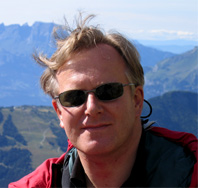
|
Documentary producer David Sington basks in a shower of
a hundred trillion solar neutrinos. Other filmmakers
might find the subject of invisible subatomic particles
daunting, but Sington couldn't resist it.

|
|
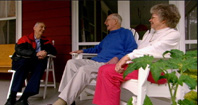
|
The people at the heart of "The Ghost Particle": John
Bahcall, left, and Ray Davis (with his wife Anna).

|
|
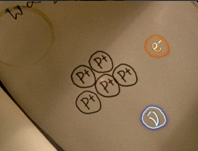
|
Keep it simple. You might not ace a physics test after
studying this diagram (as seen in the film), but you'll
learn enough to follow Sington's narrative.

|
|
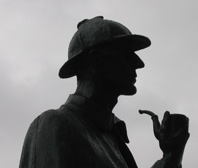
|
It's elementary: like any good detective story, a movie
should let audiences "solve" the mystery for themselves.

|
|
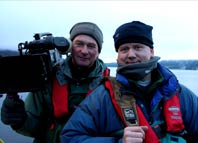
|
Rule #7 is the most critical of all: work with the best.
Here, "The Ghost Particle"'s director of photography,
Clive North (left), and sound recordist Kevin Meredith

|
|
|

